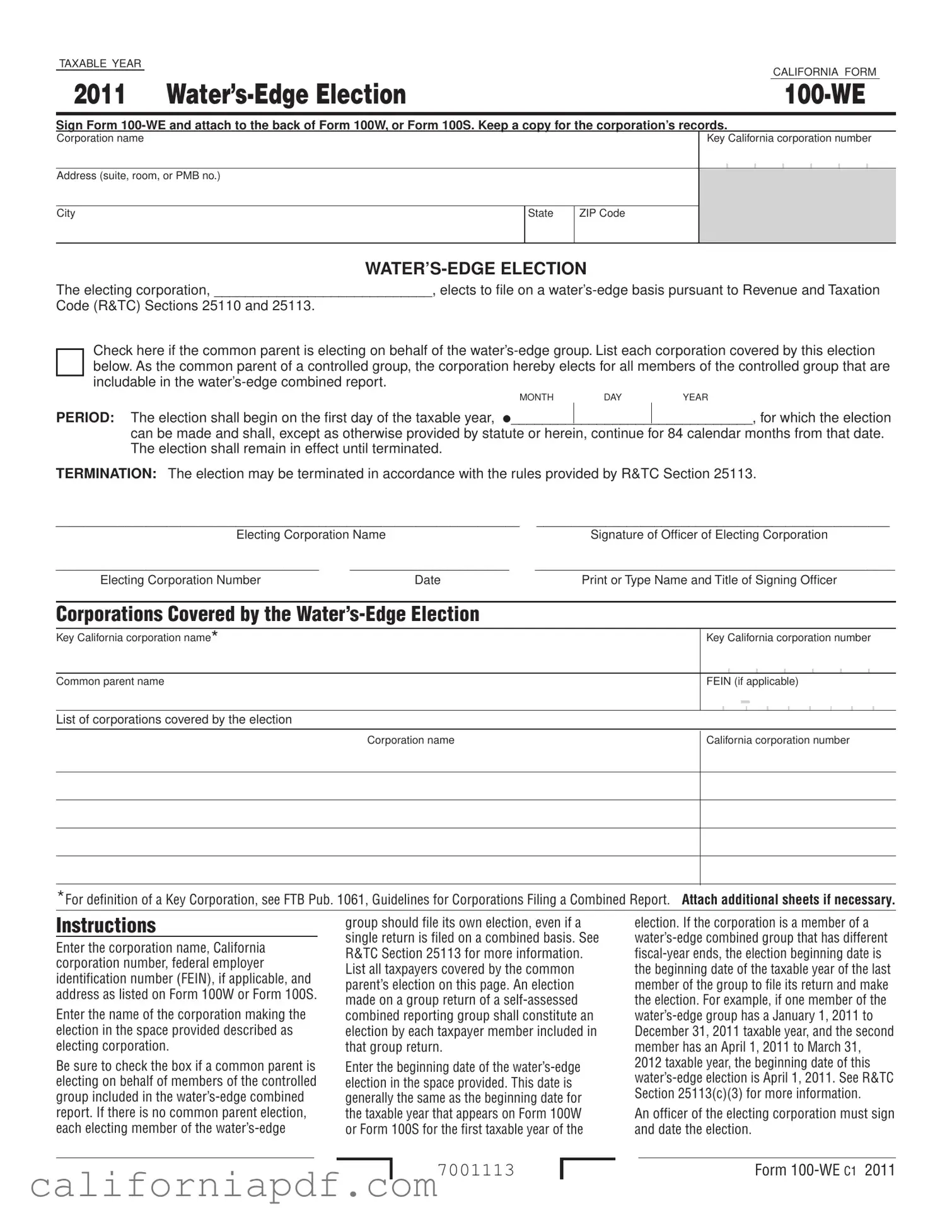The California Form 100-WE, utilized for the water’s-edge election, shares similarities with several other tax documents, each serving specific purposes but parallel in their ability to electioneer or report financial activity for tax purposes. One such document is the California Form 100W, which is used for filing corporate franchise or income tax returns on a combined reporting basis. Both forms are integral to the taxation process for corporations operating within a controlled group, allowing for the aggregation of income and deductions among affiliated entities to accurately reflect their California income tax obligations.
Similarly, the California Form 100S plays a crucial role for S corporations in California, akin to how Form 100-WE is used by corporations electing the water’s-edge method. While Form 100S is designed for S corporations to file their income tax returns, reflecting their pass-through status where income, losses, deductions, and credits flow through to shareholders, Form 100-WE applies to corporations opting for a specific international income reporting method. Both, however, require specific designations and elections to be made for the tax-filing entity.
The Federal Form 1120 stands as the U.S. Corporation Income Tax Return, paralleling the state-focused purpose of Form 100-WE by requiring corporations to report their income, gains, losses, deductions, and credits to the federal government. Even though one is federal and the other state-specific, both are essential in ensuring corporations comply with their respective tax obligations based on their operational and financial structures.
The California Form 565, the Partnership Return of Income, while primarily for partnerships, shares a structural similarity with Form 100-WE in terms of consolidating the financial activities of multiple entities for tax purposes. Form 100-WE achieves this by allowing corporations within a controlled group to be taxed on a combined basis, while Form 565 accomplishes a similar objective for partners within a partnership, aligning on the principle of collective financial reporting.
Form 568, the Limited Liability Company Return of Income in California, also resonates with the collective reporting aspect of Form 100-WE. While Form 568 is tailored for LLCs that are treated as partnerships for tax purposes, it similarly requires the aggregation of the financial details of the entity for state tax considerations, illustrating the broad application of these reporting principles across different business structures.
The Federal Form 1120S, used by S corporations to report their income, deductions, gains, losses, etc., at the federal level, reflects the intent of Form 100-WE in the aspect that both forms cater to specific entity types within the tax regime, requiring detailed financial disclosures and elections to be made to ensure accurate tax reporting and compliance based on the entity’s tax status and choices.
Form 3520, the Annual Return to Report Transactions with Foreign Trusts and Receipt of Certain Foreign Gifts, though focused on foreign transactions, aligns with Form 100-WE’s international aspect. Form 100-WE applies to corporations electing a water’s-edge basis, thus limiting the scope of their taxable income to the U.S. and certain international incomes, similar to how Form 3520 tracks international financial transactions for tax purposes.
The California Form 109, California Exempt Organization Business Income Tax Return, parallels Form 100-WE by being a specialized state tax form catered towards a specific group – in this case, nonprofits. Both forms demonstrate the customization of tax reporting requirements to accommodate the unique characteristics and activities of different organizations, ensuring that each complies with tax laws that best fit their operational nature.
Finally, the Federal Form 8832, Entity Classification Election, while not a tax return form per se, shares the elective nature with Form 100-WE. It allows entities to choose how they are classified for federal tax purposes, similar to how corporations elect to file on a water’s-edge basis with Form 100-WE. Both forms are pivotal in determining how an entity is viewed and taxed within their respective tax jurisdictions, showcasing the importance of elections in tax reporting and compliance.
Each of these documents, while serving different purposes and for different entities, shares the fundamental goal of ensuring accurate tax reporting and compliance. Whether it’s through the lens of state or federal tax, for partnerships, S corporations, or those engaging in international transactions, the essence of making specific elections or consolidating financial activity across a group for tax purposes closely ties them to the California Form 100-WE.

